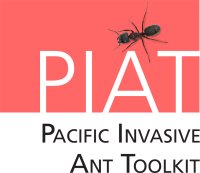5 worst threat ants to the Pacific
We focus mostly on the biology and impacts of what are considered the 5 worst invasive ant species. These are the yellow crazy ant (Anoplolepis gracilipes), the red imported fire ant (Solenopsis invicta), the African big-headed ant (Pheidole megacephala), the little fire ant (Wasmannia auropunctata) and the Argentine ant (Linepithema humile). These five species are on the International Union for the Conservation for Nature's 100 of the world’s worst invasive alien species list due to the damage they can cause, and their worldwide distributions. These are also the ants that are most commonly targeted in management programmes, because of the problems they cause.
As well as the 5 worst ants we have selected 13 other unwanted ants that can cause problems from time to time, but much less often than the 5 worst species.
| Choose the links below or click on the images on the right for detailed information.
Little fire ant : Red imported fire ant : Yellow crazy ant : African big-headed ant : Argentine ant The descriptions in this section provide information on identifying the 5 worst invasive ants that are a threat to the Pacific, and their environmental, agricultural and social impacts.The information should also help in identifying these ants using the unaided eye. Definitive identification requires a microscope (or consultation with a technical expert). The links at the bottom of each species description provide links to information on identification using a microscope. There are many invasive ant species other than the 5 worst. If the ant you are trying to identify is not one of the 5 worst, or among the 13 other most serious threat ants, then see the identification section for suggestions. Once the ant is identified, the ISSG database and CABI describe the biology and impacts of many invasive ant species. Where available we have also provided videos of the ants to assist in identifying the different species in the field. If the problem ant has been identified as one of the 5 worst, you can look at treatment options and management case studies for these species for information and examples of how to best control them. |
 |
